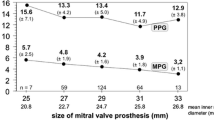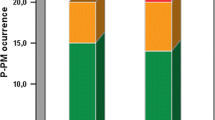Abstract
Calculation of effective orifice area (EOA) is crucial for the evaluation of prosthetic valve (PV) function and there is lack of data on the best method, particularly in obese patients, in whom two-dimensional (2D) transthoracic echocardiography (TTE) is cumbersome. We sought to compare two methods of calculating EOA through Continuity equation; one using standard 2D-TTE and other three-dimensional (3D) stoke volume (SV), in patients with bileaflet mechanical PV stratified by body mass index (BMI). On conventional TTE, SV mas measured using standard 2D derived data and 3D derived SV in 38 aortic and 62 mitral PV patients who were referred for further evaluation for mild/moderate symptoms of dyspnea. Patients were categorized with regard to transprosthetic flow into ‘normal-flow’ and ‘high-flow’ groups and several echocardiographic data including 2D and 3D EOA were compared. Rates of obesity (BMI ≥ 30) were similar within high and normal flow groups of mitral and aortic PV patients. Correlation and agreement of 2D and 3D EOA was sought in patients with and without obesity. After identifying patients with possible severe obstruction, ROC analysis was carried out to identify whether 2D and 3D derived EOA could discriminate those with obstruction. There was good correlation and agreement between two methods in patients without obesity in both mitral and aortic PV. In obese individuals, however, there was no correlation between 2D and 3D EOA; in whom echocardiographic criteria showing severe obstruction revealed that 3D EOA measurements were more accurate. ROC analysis supported that 3D EOA performs better to identify patients with obstructive characteristics. In patients with bileaflet PV, measurement of EAO by 3D derived SV yields more accurate results irrespective of BMI.




Similar content being viewed by others
References
Nishimura RA, Otto CM, Bonow RO et al (2014) AHA/ACC guideline for the management of patients with valvular heart disease. a report of the American College of Cardiology/American Heart Association Task Force on practice guidelines. Circulation 129:2440–2492
Zoghbi WA, Chambers JB, Dumesnil JG et al (2009) Recommendations for evaluation of prosthetic valves with echocardiography and doppler ultrasound. J Am Soc Echocardiogr 22:975–1014
Finkelhor RS, Moallem M, Bahler RC (2006) Characteristics and impact of obesity on the outpatient echocardiography laboratory. Am J Cardiol 97:1082–1084
Lancellotti P, Pibarot P, Chambers J et al (2016) Recommendations for the imaging assessment of prosthetic heart valves. Eur Heart J Cardiovasc Imaging 17:589–590
Hage FG, Nanda NC (2010) Guidelines for the evaluation of prosthetic valves with echocardiography and Doppler ultrasound: value and limitations. Echocardiography 27:91–93
Hahn RT, Pibarot P (2017) Accurate measurement of left ventricular outflow tract diameter: comment on the updated recommendations for the echocardiographic assessment of aortic valve stenosis. J Am Soc Echocardiogr 30:1038–1041
Clavel MA, Malouf J, Messika-Zeitoun D et al (2015) Aortic valve area calculation in aortic stenosis by CT and Doppler echocardiography. JACC Cardiovasc Imaging 8:248–257
Khaw AV, Bardeleben RS, Strasser C et al (2009) Direct measurement of left ventricular outflow tract by transthoracic real-time 3D-echocardiography increases accuracy in assessment of aortic valve stenosis. Int J Cardiol 136:64–71
Zacharoulis AA, Evans TR, Ziady GM (1975) Measurement of stroke volume from pulmonary artery pressure record in man. Br Heart J 37:20–25
Baumgartner H, Hung J, Bermejo J (2009) Echocardiographic assessment of valve stenosis: EAE/ASE recommendations for clinical practice. Eur J Echocardiogr 10:1–25
Gutiérrez-Chico JL, Zamorano JL, Prieto-Moriche E et al (2008) Real-time three-dimensional echocardiography in aortic stenosis: a novel, simple, and reliable method to improve accuracy in area calculation. Eur Heart J 29:1296–1306
DuBois D, DuBois EF (1916) A formula to estimate the approximate surface area if height and weight be known. Arch Intern Med 17:863–871
Lang RM, Badano LP, Mor-Avi V et al (2015) Recommendations for cardiac chamber quantification by echocardiography in adults. J Am Soc Echocardiogr 28:1–39
Bland JM, Altman DG (1986) Statistical methods for assessing agreement between two methods of clinical measurement. Lancet 1:307–310
Singh M, Sethi A, Mishra AK et al (2020) Echocardiographic imaging challenges in obesity: guideline recommendations and limitations of adjusting to body size. J Am Heart Assoc 9:e014609
De Divitiis O, Fazio S, Maddalena G et al (1981) Obesity and cardiac function. Circulation 64:477–482
Vasan RS (2003) Cardiac function and obesity. Heart 89:1127–1129
LaBounty TM, Miyasaka R, Chetcuti S et al (2014) Annulus instead of LVOT diameter improves agreement between echocardiography effective orifice area and invasive aortic valve area. JACC Cardiovasc Imaging 7:1065–1066
Suchá D, Symersky P, Tanis W et al (2015) Multimodality imaging assessment of prosthetic heart valves. Circ Cardiovasc Imaging 8:e003703
Messika-Zeitoun D, Serfaty JM, Brochet E et al (2010) Multimodal. J Am Coll Cardiol 55:186–194
Lavine SJ, Obeng GB (2019) The relation of left ventricular geometry to left ventricular outflow tract shape and stroke volume index calculations. Echocardiography 36:905–915
Garcia J, Marrufo OR, Rodriguez AO et al (2012) Cardiovascular magnetic resonance evaluation of aortic stenosis severity using single plane measurement of effective orifice area. J Cardiovasc Magn Reson 14:23
Pibarot P, Clavel MA (2016) Doppler echocardiographic quantitation of aortic valve stenosis: a science in constant evolution. J Am Soc Echocardiogr 29:1019–1022
Lang RM, Badano LP, Tsang W et al (2012) EAE/ASE recommendations for image acquisition and display using three-dimensional echocardiography. J Am Soc Echocardiogr 25:3–46
Shibayama K, Watanabe H, Iguchi N (2013) Evaluation of automated measurement of left ventricular volume by novel real-time 3-dimensional echocardiographic system: validation with cardiac magnetic resonance imaging and 2-dimensional echocardiography. J Cardiol 61:281–288
González-Mansilla A, Martinez-Legazpi P, Prieto A et al (2019) Valve area and the risk of overestimating aortic stenosis. Heart 105:911–919
Silbiger JJ, Lee S, Christia P et al (2019) Mechanisms, pathophysiology, and diagnostic imaging of left ventricular outflow tract obstruction following mitral valve surgery and transcatheter mitral valve replacement. Echocardiography 36:1165–1172
Author information
Authors and Affiliations
Corresponding author
Ethics declarations
Conflict of interest
The authors declare that they have no conflict of interest.
Additional information
Publisher's Note
Springer Nature remains neutral with regard to jurisdictional claims in published maps and institutional affiliations.
Rights and permissions
About this article
Cite this article
Ozkaramanli Gur, D., Baykiz, D., Gur, O. et al. Evaluation of mechanical prosthetic valves: the role of three dimensional echocardiography in calculating effective orifice area in obese vs non-obese individuals. Int J Cardiovasc Imaging 37, 215–227 (2021). https://doi.org/10.1007/s10554-020-01978-3
Received:
Accepted:
Published:
Issue Date:
DOI: https://doi.org/10.1007/s10554-020-01978-3




